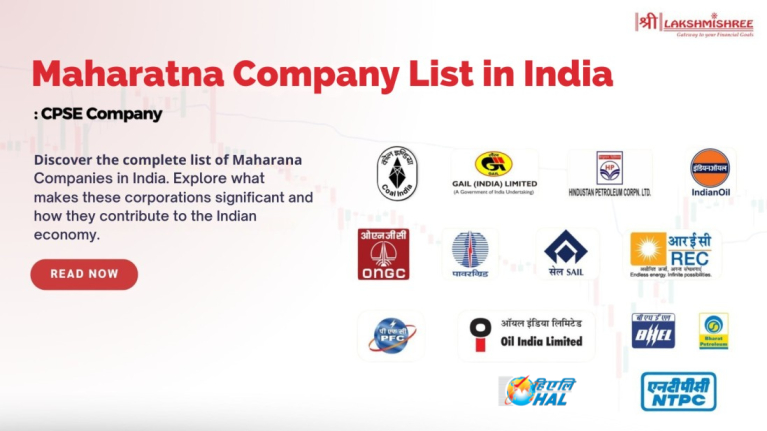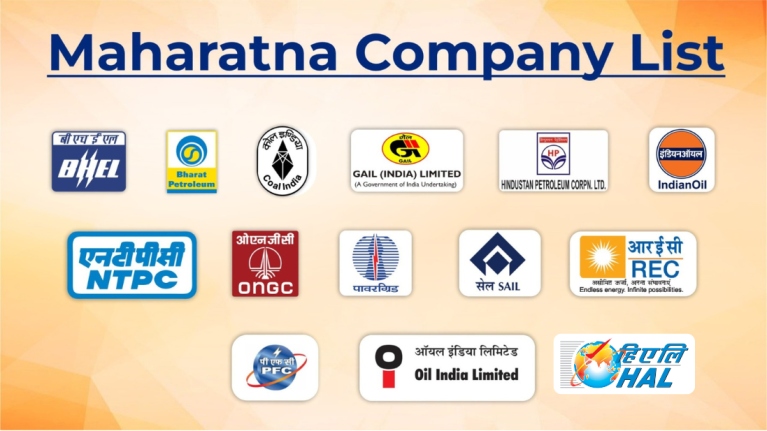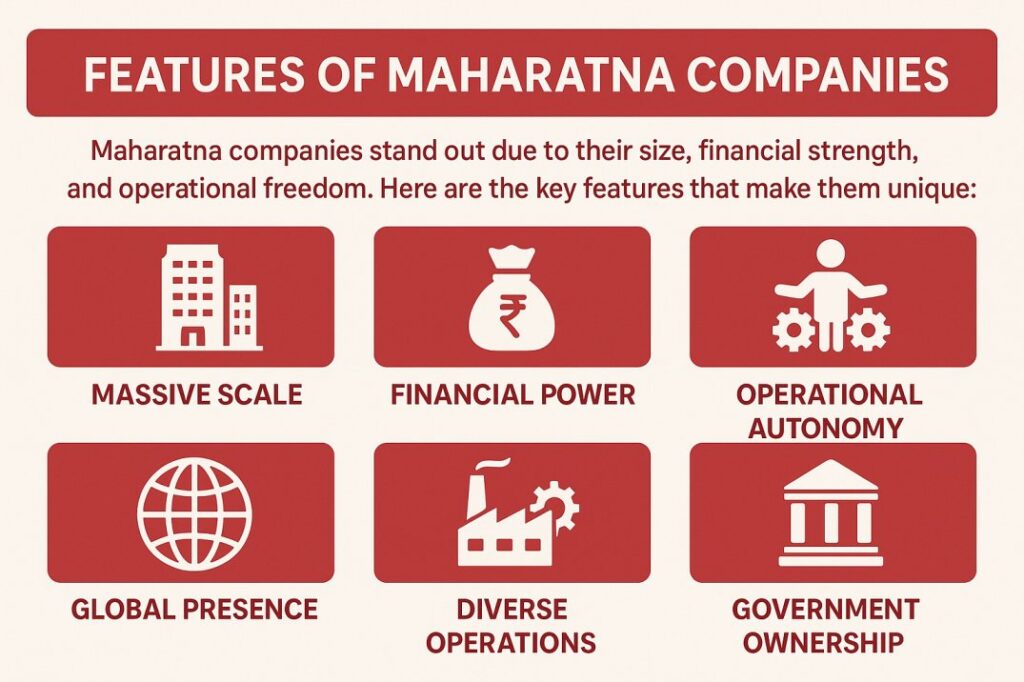
India’s public sector is home to some of the country’s most powerful companies—known as Maharatna companies. These are government-owned giants that lead in vital sectors like oil, power, steel, and infrastructure. As of 2025, India has 14 Maharatna companies. These firms enjoy special Maharatna status because of their strong financial performance, global presence, and strategic importance to the economy. With greater decision-making powers, they play a big role in shaping India’s growth story.
In this blog, we’ll explore what makes a company Maharatna, the updated Maharatna company list 2025, their key features, and why their stocks are gaining attention among Indian investors.
India's Maharatna company list for 2025 includes some of the biggest names in public sector enterprises. These companies have achieved outstanding financial performance and contributed significantly to India's economic growth. Below is a complete list of Maharatna companies and their establishment years.
This list of Maharatna companies in India highlights the diversity and strength of the Indian public sector. These companies continue to lead in their respective fields and are pivotal in India's industrial and economic development.

Below is an in-depth overview of each company from the Maharatna company list for 2025, focusing on their products, services, and key financial metrics like Market Capitalisation, Current Market Price (CMP), and Price-to-Earnings (PE) Ratio.
Bharat Heavy Electricals Limited (BHEL) is the first Maharatna company, India’s leading power equipment manufacturer, including turbines, boilers, and transformers. BHEL provides key components for thermal, hydro, and nuclear power plants. It also has a growing presence in renewable energy projects like solar and wind.
| 1Y Return (%) | 3Y Return (%) | 5Y Return (%) |
|---|---|---|
| -13.99 | 469.68 | 830.78 |
Bharat Petroleum Corporation Limited (BPCL) is a leading oil and gas industry player. It refines crude oil and markets petroleum products like LPG, petrol, and diesel. BPCL also operates upstream oil exploration and downstream fuel retailing, with thousands of petrol stations across India.
| 1Y Return (%) | 3Y Return (%) | 5Y Return (%) |
|---|---|---|
| 0.89 | 111.46 | 74.57 |
Coal India Limited (CIL) is the biggest coal mining company in the world and a core Maharatna company in India. It meets over 80% of India's coal needs, supporting power, steel, and cement industries and ensuring national energy security.
| 1Y Return (%) | 3Y Return (%) | 5Y Return (%) |
|---|---|---|
| -17.77 | 115.17 | 203.59 |
GAIL India Limited is India’s largest state-owned natural gas processing and distribution company. It handles natural gas transmission through its pipelines and is involved in gas trading, petrochemicals, and LPG production. GAIL is expanding its operations into renewable energy and plans to increase its LNG imports.
| 1Y Return (%) | 3Y Return (%) | 5Y Return (%) |
|---|---|---|
| -12.35 | 104.64 | 195.4 |
Hindustan Petroleum Corporation Limited (HPCL) is a major oil refining and marketing player, with a wide network of refineries and fuel stations across India. HPCL deals with petroleum products like LPG, petrol, and diesel and has recently expanded its presence in renewable energy.
| 1Y Return (%) | 3Y Return (%) | 5Y Return (%) |
|---|---|---|
| 12.51 | 184.85 | 178.6 |
Indian Oil Corporation Limited (IOCL) is India’s largest oil refining and marketing company, with a significant presence in domestic and international markets. IOCL operates refineries, pipelines, and fuel stations, providing fuel like LPG, petrol, diesel, and aviation.
| 1Y Return (%) | 3Y Return (%) | 5Y Return (%) |
|---|---|---|
| -14.63 | 36.62 | 153.17 |
NTPC Limited is the largest power producer in India, operating thermal power plants and expanding into solar and wind energy. It generates electricity and supplies it to state-owned power distribution companies. NTPC's focus on renewable energy is steadily increasing, making it a key player in India's clean energy goals.
| 1Y Return (%) | 3Y Return (%) | 5Y Return (%) |
|---|---|---|
| -7.45 | 138.88 | 266.67 |
Oil & Natural Gas Corporation Limited (ONGC) is India’s largest oil and gas exploration and production company. It plays a crucial role in meeting the country’s energy demands by exploring, drilling, and refining oil and natural gas. ONGC also engages in petrochemicals and renewable energy ventures, making it a key player in India’s energy sector.
| 1Y Return (%) | 3Y Return (%) | 5Y Return (%) |
|---|---|---|
| -8.22 | 78.69 | 200.18 |
Power Finance Corporation (PFC) is the 12th Maharatna company and a government-owned financial institution that provides loans to power sector projects across India. It is crucial in financing infrastructure projects related to power generation, transmission, and distribution.
Returns:
| 1Y Return (%) | 3Y Return (%) | 5Y Return (%) |
|---|---|---|
| -19.1 | 410.49 | 502.84 |
Power Grid Corporation of India Limited is a Maharatna company that manages the country’s entire high-voltage electricity transmission system. It ensures reliable electricity supply from power producers to distribution networks.
| 1Y Return (%) | 3Y Return (%) | 5Y Return (%) |
|---|---|---|
| -12.01 | 81.69 | 221 |
Steel Authority of India Limited (SAIL) is the largest steel producer in India, manufacturing a wide range of steel products used in construction, automotive, and other industries. SAIL has an integrated steel production setup and operates some of the largest steel plants in India.
| 1Y Return (%) | 3Y Return (%) | 5Y Return (%) |
|---|---|---|
| -15.31 | 85.52 | 341.7 |
Rural Electrification Corporation Limited (REC) is a key Maharatna PSU in financial services that funds power sector projects, especially rural electrification. It supports power generation, transmission, and distribution in underserved areas.
| 1Y Return (%) | 3Y Return (%) | 5Y Return (%) |
|---|---|---|
| -22.6 | 371.69 | 401.7 |
Oil India Limited (OIL) is the 13th Maharatna company in India and also the second-largest oil and gas exploration company, focusing primarily on crude oil and natural gas production. The company also explores alternative energy sources, making it a key player in the country’s energy mix.
| 1Y Return (%) | 3Y Return (%) | 5Y Return (%) |
|---|---|---|
| 4.42 | 183.32 | 644.58 |
Hindustan Aeronautics Limited (HAL) is the 14th Maharatna company in India. It is a leading aerospace and defence company, engaged in the design, manufacture, and maintenance of aircraft, helicopters, engines, and avionics. HAL plays a crucial role in India's defence sector, supporting both the Indian Air Force and space research initiatives.
| 1Y Return (%) | 3Y Return (%) | 5Y Return (%) |
|---|---|---|
| -4.77 | 432.86 | 1328.41 |
A Maharatna company is a top-level public sector enterprise (PSE) in India that operates under the ownership of the Central Government. These companies have a strong financial track record and play a key role in India’s economic growth and infrastructure development.
As of 2025, there are 14 Maharatna companies in India, operating in critical sectors like oil & gas, power, coal, steel, and finance. They are given more autonomy by the Government of India to take big investment decisions without needing prior approvals. This helps them compete globally and expand their business faster. Maharatna status is considered the highest recognition for a central public sector enterprise in India.hout needing prior approvals. This helps them compete globally and expand their business faster. Maharatna status is considered the highest recognition for a central public sector enterprise in India.
India’s Central Public Sector Enterprises (CPSEs) are divided into three major categories based on their size, performance, and financial autonomy. Here’s a quick comparison to understand the difference between Maharatna, Navratna, and Miniratna:
Maharatna companies stand out due to their size, financial strength, and operational freedom. Here are the key features that make them unique:

To become a Maharatna, a company must already hold Navratna status and meet specific financial and operational benchmarks set by the Government of India.
Here are the key eligibility criteria for Maharatna status:
Once these conditions are fulfilled, the Department of Public Enterprises (DPE) under the Ministry of Finance officially grants Maharatna status.
Investing in Maharatna companies' stocks offers financial stability and long-term growth potential. These companies operate in key sectors like energy, infrastructure, and steel, vital for India’s economy. Due to their consistent profitability, Maharatna companies are known for providing regular dividends, making them an attractive option for income-focused investors.
Additionally, their government backing reduces investment risk, and their large-scale operations mean they are less affected by market volatility. Maharatna companies offer a balanced mix of growth, security, and reliability for those seeking long-term capital appreciation and steady returns.
Investing in Maharatna companies is straightforward, much like investing in other stocks. Below are the simple steps to get started:
Maharatna companies contribute to India’s GDP, job creation, innovation, and government revenue—making them key pillars of economic development in 2025.
Maharatna companies face several challenges but have unique opportunities to grow and expand. Here are the key points:
Challenges:
Opportunities:
As of 2025, the top Maharatna companies in India continue to play a powerful role in shaping the country’s economy. These large CPSEs lead key sectors like oil & gas, power, steel, and finance—driving growth, employment, and national development.
With strong government backing and consistent performance, Maharatna companies offer long-term investment stability
The Maharatna company list for 2025 includes 14 top-performing public sector enterprises. These include ONGC, NTPC, Coal India, BHEL, Power Grid, Indian Oil, BPCL, HPCL, GAIL, SAIL, Oil India, REC, PFC, and IOCL. These companies operate across energy, infrastructure, finance, and manufacturing sectors, and hold the highest level of autonomy granted by the Indian government.
As of 2025, there are 14 Maharatna companies in India. Hindustan Aeronautics Limited (HAL) was the most recent company to receive Maharatna status, making it the 14th enterprise on the list.
Maharatna companies are the biggest and most financially autonomous CPSEs. Navratna companies enjoy moderate operational freedom, while Miniratna companies have limited autonomy and are divided into Category I and II. The classification depends on financial strength, scale of operations, and global presence, with Maharatna at the top.
Maharatna companies are large, financially stable enterprises that offer consistent dividends, strong market performance, and long-term growth potential. They are backed by the government, making them relatively safer investment options.
A company must first hold Navratna status and meet strict criteria, including a minimum annual turnover of ₹25,000 crore, a net worth exceeding ₹15,000 crore, and profitability benchmarks over the last three years.
Bharat Heavy Electricals Limited (BHEL) became the first company to achieve Maharatna status. This milestone was achieved after BHEL consistently demonstrated strong financial performance and a significant global presence, marking it as a leader in India's energy sector.
Maharatna is the highest classification for public sector enterprises in India, giving companies more autonomy and financial freedom than Navratna companies, which fall under the second tier.
Disclaimer: This article is intended for educational purposes only. Please note that the data related to the mentioned companies may change over time. The securities referenced are provided as examples and should not be considered as recommendations.